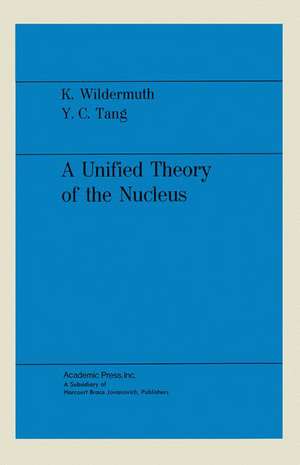A Unified Theory of the Nucleus
Autor Karl Wildermuthde Limba Germană Paperback – 1977
Preț: 459.38 lei
Nou
Puncte Express: 689
Preț estimativ în valută:
87.91€ • 92.08$ • 72.85£
87.91€ • 92.08$ • 72.85£
Carte tipărită la comandă
Livrare economică 08-22 aprilie
Preluare comenzi: 021 569.72.76
Specificații
ISBN-13: 9783528083731
ISBN-10: 3528083735
Pagini: 400
Ilustrații: 389 S.
Dimensiuni: 152 x 229 x 21 mm
Greutate: 0.53 kg
Ediția:Softcover reprint of the original 1st ed. 1977
Editura: Vieweg+Teubner Verlag
Colecția Vieweg+Teubner Verlag
Locul publicării:Wiesbaden, Germany
ISBN-10: 3528083735
Pagini: 400
Ilustrații: 389 S.
Dimensiuni: 152 x 229 x 21 mm
Greutate: 0.53 kg
Ediția:Softcover reprint of the original 1st ed. 1977
Editura: Vieweg+Teubner Verlag
Colecția Vieweg+Teubner Verlag
Locul publicării:Wiesbaden, Germany
Public țintă
ResearchCuprins
1. Introduction.- 1.1. General Remarks.- 1.2. Difficulties of Some Reaction Theories.- 2. Reformulation of the Schrödinger Equation.- 3. Discussion of the Basis Wave Functions for Nuclear Systems.- 3.1. General Remarks.- 3.2. Qualitative Discussion of Cluster Correlations.- 3.3. Construction of Oscillator Cluster Wave Functions.- 3.4. Discussion of 8Be as an Illustrative Example.- 3.5. Effects of Antisymmetrization.- 3.6. Applications of Oscillator Cluster Representations to a Qualitative Description of Low-Lying Levels in Light Nuclei.- 3.7. Construction of Generalized Cluster Wave Functions.- 4. Formulation of a Unified Microscopic Nuclear Structure and Reaction Theory.- 4.1. General Remarks.- 4.2. Specific Examples.- 4.3. Extension to General Systems.- 5. Bound-State Calculations.- 5.1. General Remarks.- 5.2. Calculation of Matrix Elements.- 5.3. Ground and Low Excited States of 6Li.- 5.4. Low-Energy T = 0 States of 12C.- 5.5. Low-Lying Levels of 7Be.- 5.6. Concluding Remarks.- 6. Further Comments About the Pauli Principle.- 6.1. General Remarks.- 6.2. Cluster Overlapping and Pauli Principle.- 6.3. Energetical Favouring of a Cluster Inside a Large Nucleus.- 7. Scattering and Reaction Calculations.- 7.1. General Remarks.- 7.2. Derivation of Coupled Equations.- 7.3. Quantitative Results.- 7.4. Concluding Remarks.- 8. Introductory Considerations About the Derivation of General Nuclear Properties.- 8.1. General Remarks.- 8.2. Introduction of Effective Hamiltonians.- 8.3. Elimination of Linear Dependencies.- 8.4. Concluding Remarks.- 9. Breit-Wigner Resonance Formulae.- 9.1. General Remarks.- 9.2. Single-Level Resonance Formula for Pure Elastic-Scattering.- 9.3. Many-Level Resonance Formula for Pure Elastic-Scattering.- 9.4. Single-Level Resonance Formula IncludingInelastic and Rearrangement Processes.- 9.5. Mutual Influence of Resonance Levels in Inelastic and Rearrangement Processes.- 9.6. Behaviour of the Partial Level Width Near a Threshold and Energy-Dependent Width Approximation.- 10. Resonance Reactions and Isobaric-Spin Mixing.- 10.1. General Remarks.- 10.2. Isobaric-Spin Mixing in the Compound Region.- 10.3. Isobaric-Spin Mixing in the Incoming Channel.- 11. Optical-Model Potentials for Composite Particles.- 11.1. General Remarks.- 11.2. Optical-Model Description of Elastic-Scattering Processes.- 11.3. Specific Examples.- 11.4. Features of Effective Local Potentials between Nuclei.- 12. Direct Reactions.- 12.1. General Remarks.- 12.2. Derivation of the General Formulae.- 12.3. Specific Examples.- 12.4. Influence of the Pauli Principle on Direct-Reactions.- 12.5. Concluding Remarks.- 13. Some Considerations About Heavy-Ion Transfer Reactions.- 13.1. General Remarks.- 13.2. Specific Examples to Study the Influence of Antisymmetrization.- 13.3. Further Discussion of the Odd-Even Feature in the Effective Potential between Nuclei.- 13.4. Concluding Remarks.- 14. Collective States.- 14.1. General Remarks.- 14.2. Rotational States of Even-Even Nuclei with K = 0.- 14.3. Generalization of Rotational Wave Functions.- 14.4. Energetical Preference of Rotational Configurations.- 14.5. Electromagnetic Transitions between Rotational Levels.- 14.6. Relationship with other Descriptions of Nuclear Rotational States.- 14.7. Construction of Intrinsic Wave Functions for Quantitative Studies of Collective States in Medium-Heavy and Heavy Nuclei.- 14.8. Specific Examples.- 14.9. Concluding Remarks.- 15. Brief Discussion of Time-Dependent Problems.- 15.1. General Remarks.- 15.2. Connection between the Lifetime of a Compound State and Its LevelWidth.- 15.3. Time-Dependent Projection Equation with Time-Dependent Interaction.- 16. Qualitative Considerations of Some Nuclear Problems.- 16.1. General Remarks.- 16.2. Coulomb-Energy Effects in Mirror Levels.- 16.3. Reduced Widths and ?-Transition Probabilities.- 16.4. Level Spectra of Neighbouring Nuclei.- 16.5. Optical Resonances in Nuclear Reactions.- 17. Nuclear Fission.- 17.1. General Remarks.- 17.2. Substructure Effects in Fission Processes.- 17.3. Mass Distribution of Fission Fragments.- 17.4. Deformation Energy of Fissioning Nucleus.- 18. Conclusion.- Appendix A — Cluster Hamiltonians and Jacobi Coordinates.- Appendix B — Designation of Oscillator States.- Appendix C — Demonstration of the Projection Technique.- Appendix D — Connection with Conventional Direct-Reaction Theory.- References.


